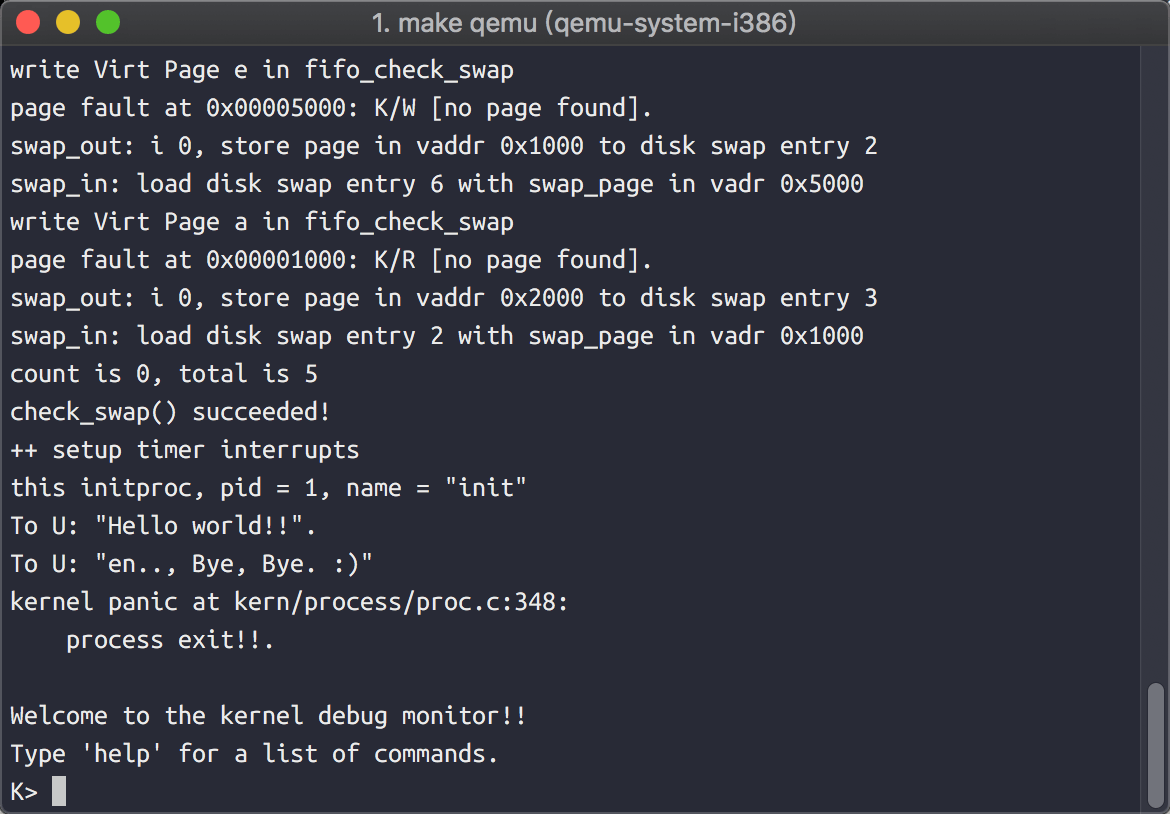练习0:填写已有实验
本实验依赖实验1/2/3。请把你做的实验1/2/3的代码填入本实验中代码中有“LAB1”,“LAB2”,“LAB3”的注释相应部分。
1
| vmm.c trap.c default_pmm.c pmm.c swap_fifo.c 这几个补上去就完事了
|
练习1:分配并初始化一个进程控制块
alloc_proc函数(位于kern/process/proc.c中)负责分配并返回一个新的struct proc_struct结构,用于存储新建立的内核线程的管理信息。ucore需要对这个结构进行最基本的初始化,你需要完成这个初始化过程。
【提示】在alloc_proc函数的实现中,需要初始化的proc_struct结构中的成员变量至少包括:state/pid/runs/kstack/need_resched/parent/mm/context/tf/cr3/flags/name。
1
2
3
4
5
6
7
8
9
10
11
12
13
14
15
16
17
18
19
| 很简单 按照进程控制块的内容填写就行了
static struct proc_struct *alloc_proc(void) {
struct proc_struct *proc = kmalloc(sizeof(struct proc_struct));
if (proc != NULL) {
proc->state = PROC_UNINIT;
proc->pid = -1;
proc->runs = 0;
proc->kstack = 0;
proc->need_resched = NULL;
proc->parent = NULL;
proc->mm = NULL;
memset(&(proc->context), 0, sizeof(struct context));
proc->tf = NULL;
proc->cr3 = boot_cr3;
proc->flags = 0;
memset(&(proc->name), 0, PROC_NAME_LEN);
}
return proc;
}
|
请在实验报告中简要说明你的设计实现过程。请回答如下问题:
- 请说明proc_struct中struct context context和struct trapframe *tf成员变量含义和在本实验中的作用是啥?(提示通过看代码和编程调试可以判断出来)
1
2
3
4
5
6
7
8
9
10
11
| context 中 保存着各种寄存器的内容 这是为了保存进程上下文 为进程调度做准备
struct context {
uint32_t eip;
uint32_t esp;
uint32_t ebx;
uint32_t ecx;
uint32_t edx;
uint32_t esi;
uint32_t edi;
uint32_t ebp;
};
|
1
2
3
4
5
6
7
8
9
10
11
12
13
14
15
16
17
18
19
20
21
22
23
24
25
26
27
28
29
30
31
32
33
34
| trapframe 保存着 用于特权级转换的 栈 esp 寄存器
当进程发生特权级转换的时候 中断帧记录了进入中断时任务的上下文 当退出中断时 恢复环境
struct trapframe {
struct pushregs {
uint32_t reg_edi;
uint32_t reg_esi;
uint32_t reg_ebp;
uint32_t reg_oesp;
uint32_t reg_ebx;
uint32_t reg_edx;
uint32_t reg_ecx;
uint32_t reg_eax;
};
uint16_t tf_gs;
uint16_t tf_padding0;
uint16_t tf_fs;
uint16_t tf_padding1;
uint16_t tf_es;
uint16_t tf_padding2;
uint16_t tf_ds;
uint16_t tf_padding3;
uint32_t tf_trapno;
uint32_t tf_err;
uintptr_t tf_eip;
uint16_t tf_cs;
uint16_t tf_padding4;
uint32_t tf_eflags;
uintptr_t tf_esp;
uint16_t tf_ss;
uint16_t tf_padding5;
} __attribute__((packed));
|
![pcb]()
练习2:为新创建的内核线程分配资源
创建一个内核线程需要分配和设置好很多资源。kernel_thread函数通过调用do_fork函数完成具体内核线程的创建工作。do_kernel函数会调用alloc_proc函数来分配并初始化一个进程控制块,但alloc_proc只是找到了一小块内存用以记录进程的必要信息,并没有实际分配这些资源。ucore一般通过do_fork实际创建新的内核线程。do_fork的作用是,创建当前内核线程的一个副本,它们的执行上下文、代码、数据都一样,但是存储位置不同。在这个过程中,需要给新内核线程分配资源,并且复制原进程的状态。你需要完成在kern/process/proc.c中的do_fork函数中的处理过程。它的大致执行步骤包括:
- 调用alloc_proc,首先获得一块用户信息块。
- 为进程分配一个内核栈。
- 复制原进程的内存管理信息到新进程(但内核线程不必做此事)
- 复制原进程上下文到新进程
- 将新进程添加到进程列表
- 唤醒新进程
- 返回新进程号
1
2
3
4
5
6
7
8
9
10
11
12
13
14
15
16
17
18
19
20
21
22
23
24
25
26
27
28
29
| 跟着注释做就是了
先是创建一个进程控制块 然后设置进程控制块
要特别注意的是 设置 进程/线程 的 PID 调用的 get_pid() 方法 和 添加进程/线程到链表中时 要将中断暂时关闭
避免执行的中途被再次中断
int do_fork(uint32_t clone_flags, uintptr_t stack, struct trapframe *tf) {
if ((proc = alloc_proc()) == NULL) {
goto fork_out;
}
proc->parent = current;
if (setup_kstack(proc) != 0) {
goto bad_fork_cleanup_proc;
}
if (copy_mm(clone_flags, proc) != 0) {
goto bad_fork_cleanup_kstack;
}
copy_thread(proc, stack, tf);
bool intr_flag;
local_intr_save(intr_flag);
{
proc->pid = get_pid();
hash_proc(proc);
nr_process++;
list_add(&proc_list, &(proc->list_link));
}
local_intr_restore(intr_flag);
wakeup_proc(proc);
ret = proc->pid;
}
|
请在实验报告中简要说明你的设计实现过程。请回答如下问题:
- 请说明ucore是否做到给每个新fork的线程一个唯一的id?请说明你的分析和理由。
1
2
| 可以保证 每个fork的线程 唯一ID
调用的 get_pid() 函数 每次都从 进程控制块链表中 找到合适的ID
|
练习3:阅读代码,理解 proc_run 函数和它调用的函数如何完成进程切换的
请在实验报告中简要说明你对proc_run函数的分析。并回答如下问题:
1
2
3
4
5
6
7
8
9
10
11
12
13
14
15
16
| 当前进程/线程 切换到 proc 这个进程/线程
void proc_run(struct proc_struct *proc) {
if (proc != current) {
bool intr_flag;
struct proc_struct *prev = current, *next = proc;
local_intr_save(intr_flag);
{
current = proc;
load_esp0(next->kstack + KSTACKSIZE);
lcr3(next->cr3);
switch_to(&(prev->context), &(next->context));
}
local_intr_restore(intr_flag);
}
}
|
1
2
| 两个内核线程 一个为 idle_proc 为 第 0 个内核线程 完成内核中的初始化 然后调度执行其他进程或线程
另一个为 init_proc 本次实验的内核线程 只用来打印字符串
|
- 语句local_intr_save(intr_flag);….local_intr_restore(intr_flag);在这里有何作用?请说明理由
1
| 关闭中断 避免进程切换的中途 再被中断(其他进程再进行调度)
|
最后还是附上执行结果 可以去🍚了 好冷 这周怕是 2018年 广东最冷的一周了
![lab4_finish]()
讲讲 switch_to 切换进程
吃完饭回来了 顺便讲讲这个 switch_to 的汇编
1
2
3
4
5
6
7
8
9
10
11
12
13
14
15
16
17
18
19
20
21
22
23
24
25
26
27
28
29
30
31
32
33
34
35
36
37
38
39
40
41
42
| struct context {
uint32_t eip
uint32_t ebx
uint32_t ecx
uint32_t edx
uint32_t esi
uint32_t edi
uint32_t ebp
}
switch_to 的作用是 保存当前进程的上下文 并且 恢复被调度上处理机的进程的上下文
.text
.globl switch_to
switch_to: # switch_to(from, to)
调用 switch_to 后栈的情况 | To esp + 8 |
| From esp + 4 |
| Ret Addr <- esp |
movl 4(%esp), %eax 此处要取的是 From 因此为 esp + 4
popl 0(%eax) pop 掉返回地址 存到 From 的 eip 中 From 的 context eip为栈底 故而 context 的 eip 当返回地址
movl %esp, 4(%eax) 这之后都只是将寄存器的内容 移到 context 相应的地址而已
movl %ebx, 8(%eax)
movl %ecx, 12(%eax)
movl %edx, 16(%eax)
movl %esi, 20(%eax)
movl %edi, 24(%eax)
movl %ebp, 28(%eax)
此时的 栈的情况 | To esp + 4 |
因为在上面已经将 返回地址 pop掉了 因此这里没有返回地址了 | From <- esp |
movl 4(%esp), %eax 此处要取 To 的地址 因为 返回地址之前已经被 pop掉了 所以此时为 esp + 4
movl 28(%eax), %ebp 这之后也没啥好说的 都是将 context 移到寄存器 恢复环境
movl 24(%eax), %edi
movl 20(%eax), %esi
movl 16(%eax), %edx
movl 12(%eax), %ecx
movl 8(%eax), %ebx
movl 4(%eax), %esp
pushl 0(%eax) eip 作返回地址 因为原先的 返回地址已经被pop掉了
ret
|

